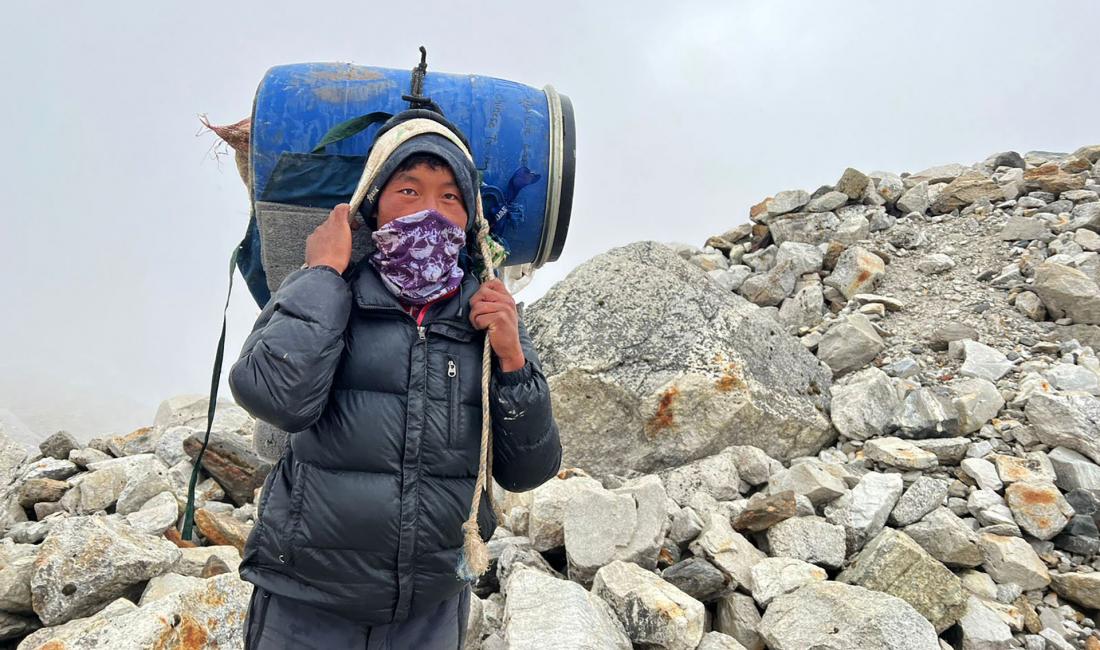How the world's highest rural municipality solves a poopy problem
This report was originally published and produced by Asia Democracy Chronicles. Photo also for Asia Democracy Chronicles by Tanka Dhakal
Last year, before the official climbing season began on Mt. Everest, Khumbu Pasang Lhamu Rural Municipality–home to the world’s highest mountain – introduced a new rule mandating climbers to bring their poop from higher camps down to the base camp.
Due to extreme cold temperatures, excrement left on Everest does not fully degrade, and pollution caused by mountaineering activities, including human feces, had become a significant issue.
But implementing this new rule has been challenging, as it operates on an honor system and there is no defined punishment yet for anyone who decides not to follow. Still, the latest statistics regarding waste—human feces and other kinds—collected at the Everest Base Camp (EBC) indicate that many climbers are bringing their poop down from the peak.
That means that Mt. Everest’s summit may no longer be doomed to become the world’s highest poop museum. Too, the men who are tasked with carrying the waste from the base camp down to lower elevations will also be making more trips if they do not want to haul bigger piles of it at a time.
Records from the Sagarmatha Pollution Control Committee (SPCC) show that as the number of climbers and their helpers increases, so does the volume of the poop and food waste at the EBC. In the spring climbing season of 2016, 13,184 kilograms of human waste and 3,456 kg of kitchen waste were recovered. These numbers doubled in the 2024 season: waste carriers recovered 27,533 kg of poop and 14,150 kg of food waste.
In 2023, SPCC said there were 21,507 kg of recovered human waste during the spring season, which runs from the second week of March to the first week of June. Considering that there were 10 % more climbers during spring that year than in 2024, it may well be that part of the increase in recovered human waste last spring was because of the new rule.
The waste carriers Asia Democracy Chronicles (ADC) talked to do not seem to mind the added volume of poop, though. After all, the more waste they are able to bring down, the more they will earn.
Then again, their rates have not really changed in the last several years. And while climbers receive recognition and media coverage after their summits, the waste carriers often face discrimination due to the nature of their work despite their huge contributions to keeping Mt. Everest as clean as possible.
“There have been countless incidents where people talked about us in derogatory ways and looked down on us,” said Durga Prashad Rai, who has been leading a team of workers carrying poop and food waste from the base camp for the past 10 years. “I don’t know if we share in their (climbers’) success, but I do feel we have a part in keeping our mountain clean.”
Difficult waste management
Mt. Everest is the ultimate goal for climbers to conquer. For people who are not able to climb to the top of the world but are into mountaineering and trekking, reaching at least the EBC—located on the top of the active Khumbu Glacier at an elevation of 5,364 meters—is their goal. This aspiration leads hundreds of mountaineers and thousands of trekkers to the base in the Solukhumbu district of Nepal every year.
According to official data, every year, more than 400 climbers from around the world receive permits from the Nepal government to climb Mt. Everest. This number is consistently growing. During the main climbing season that lasts from March to May, climbers and their teams set up tents at the EBC.
Around 1,000 people stay there for at least 50 to 60 days before ascending to the summit. On top of that are the estimated 50,000 people each year who have the EBC as their target destination.
As the rocky, icy, and permafrost-covered Khumbu region welcomes thousands of people, it also faces the challenge of managing the waste they produce. In a 2024 report, CNN quoted Jinesh Sindurakar of the Nepal Mountaineering Association as estimating that “each person produces 250 grams of excrement a day.”
Given the region’s year-round freezing weather, human feces are one of the most difficult types of waste to manage at Everest. “If it is left there, it will not decompose and will remain as it is,” said SPCC President Lama Kaji Sherpa “We have to make sure that no waste is left at the base camp, including poop and kitchen waste.”
Along the trekking trail, which starts from Lukla, some 65 kms from the EBC, there are more than 2,000 stone and wooden bins meant to collect plastics, paper, and other kinds of waste. The local government of Khumbu Pasang Lhamu, community groups, and SPCC maintain these bins and collect the waste for secure management.
“But managing human poop from the base camp was always a struggle,” Lama Kaji Sherpa said. “And we have to ensure that such a critical issue is not ignored.”
The solution came through the efforts of workers who carry the waste to lower elevations. In 2024, 16 people transported the collected feces from the base camp to a dedicated dumping site between Lobuche and Gorakshep at around 5,100 meters elevation. The dumping ground is about 4 kms of rocky trail from the base camp.
The toilet trail
Every year, before the climbing season starts, an SPCC team of field workers goes to the EBC and sets up temporary toilets. “We have been doing this for more than 20 years,” said SPCC Base Camp Manager Tshering Tenzing Sherpa. “Our team ensures that no human waste is left there, and we bury it in solid form at a dedicated dumping site.”
Up to 20 people, including two leaders, are assigned to manage the human and kitchen waste produced at the base camp. Durga Prashad Rai explained the process: “We set up more than 100 temporary toilets there. For every climbing group, there will be an assigned toilet to poop with a blue basket underneath, and for urinating, there is no basket.” Pee is not collected.
When the blue basket is 80 to 90 percent filled with feces, carriers like Karma Rai remove it and place an empty one in its place.
“These baskets have the capacity to store up to 70 kg of waste,” Karma said. “Every day, we check these baskets to see if they are filled. Whichever is filled, we carry it to the dumping site.”
The carriers earn NPR 220 (US$1.60) per kg of poop and NPR 190 (US$1.40) per kg of food or kitchen waste. Karma and his colleagues carry the waste on their backs with the help of a traditional bamboo basket called doko and rope.
Karma said that he is able to transport at least two loads of waste from the EBC to the dumping site every day. “I don’t know how much I make on a daily basis,” he said. “Our leader keeps records and gives us our share at the end of the season.”
According to team leader Durga Rai, each worker on average gets NPR250,000 (US$1,827) at the end of the season. “All of them receive their share according to how much poop or food waste they carried from EBC to the dumping site,” he said. “We don’t take any commission or fee from their wages, but it’s still low for this kind of work in such risky, high-altitude terrain.”
Few people, in fact, realize how the waste carriers are helping keep Mt. Everest from literally turning into a wasteland. Purnima Shrestha, who made history by becoming the first woman to reach Mt. Everest’s summit three times in a single season (betweenMay 12-25, 2024), was surprised to hear that there were actually people making treks to collect human waste.
“I did not know where all the poop goes from the base camp and who carries it,” said Shrestha, who has summited eight of the world’s 8,000-meter peaks. She added that she knew of the new rule requiring climbers to carry their poop down to the base camp, and had done that, “but I didn’t know anyone carried it from there.”
When they are not carrying poop down the mountains, the Everest waste workers either go back to their hometowns temporarily or work in construction. But once the trekkers and climbers start showing up, they are ready to go up Everest as well. For them, cleaning and poop-carrying jobs are not only ways of earning a living, but also a shared responsibility of looking after what many Nepalis consider a “mother-like” mountain.
Said Karma Rai, a smile spreading across his face: “I am happy with this mountain and happy with what I am doing.”



